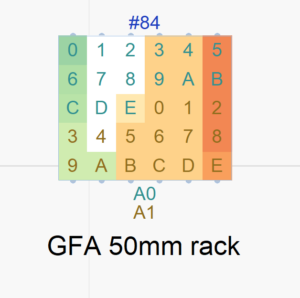To create a rack with multiple rows of tubes or tube holders, and to have that rack appear in rack layout diagrams with the pin number text oriented upright, it is necessary to understand Finale 3D‘s definition of “row” and “standard orientation”.
The meaning of “row” in rack definitions in Finale 3D is a line of tubes that either tilt together or fan out along the line. This meaning makes sense for wooden racks for shells, because everyone would agree that the rack in Figure 1 is one row of tubes.

Figure 1 –The meaning of “row” in rack definitions is a line of tubes that either tilt together or fan out along the line.
For racks with multiple rows, row #1 is on the left in the orientation of the rack definition, which would point toward the audience or down in the rack layout view if the rack is not rotated. Imagine if the rack of Figure 1 had four rows, side by side, and the tubes could fan out within the rows, i.e., a Fan row rack. It would look a lot like the rack in Figure 2.

Figure 2 –In fan row racks, the rows are perpendicular to the pivot rods that the holders rotate around.
In fan row racks, the rows are perpendicular to the pivot rods that the holders rotate around. It is easy to tell how many rows a fan row rack has by just by looking at the knobs on the ends of the rods. Count the number of tube holders that rotate around a rod. That’s the number of rows! Fan row racks are usually rotated 90° counter-clockwise to make the rows aim sideways for tubes within them to make left/right fans from the audience perspective.

Figure 3 –In tiltable row racks, the rows are the tracks that the tubes slide onto.
In a Tiltable Row Rack like in Figure 3, the rows are the tracks that the tubes slide onto. To tell how many rows a tiltable row rack has, just count the tracks. Tiltable row racks are usually not rotated in the rack layout because the rows aim forward and tilt sideways to make left/right fans from the audience perspective.
A trick to remember
A trick to remember the row orientation in the rack definitions versus when rotated in the rack layout view is: Hold your left arm out in front of you, wrist bent, fingers together pointing down. Your fingers are the rows, pinky finger being row #1. The tube numbers counting “By rows, left to right” start with the first pin at the base of the pinky finger, progressing down to the finger tip, then continuing at the base of the ring finger. If the rack is rotated 90° counter-clockwise to make the rows horizontal from the audience perspective, that’s like rotating your hand 90° counter-clockwise. In that orientation the first row represented by your pinky finger is closest to the ground, which is equivalent to closest to the audience in the rack layout view.
Finale 3D includes options to count tubes in other orders like “By rows, right to left” and “Across rows, right to left” (see Tube loading order). You can use the hand/finger trick to visualize the tube numbers in the rack definition versus rotated in the rack layout. The order definitions are interpreted in the orientation of the rack definition (left hand fingers pointing down). Thus the order “By rows, right to left” begins with pin 1 at the base of the index finger, progressing to the finger tip. If the rack is rotated 90° counter-clockwise in the rack layout, pin 1 would be in the back left, and pins 2, 3, 4, … would progress to the right.
Standard orientation
In shows, fan row racks are usually oriented with the fan angles going from side to side. Finale 3D offers the choice in the “Create rack” dialog to change the standard orientation of the rack to be rotated 90° counter-clockwise to make rows sideways to the audience by default. Changing the standard orientation doesn’t change the meaning of rows in the rack definition. It just changes the default orientation that the rack will appear in when added to the show, and it changes the orientation of the pin number text and other text to be upright when the rack is in its standard orientation.

Figure 4 –The standard orientation dictates the orientation of the pin number text and other text.
When adding racks to the rack layout of a show, the racks must be in the correct orientation to accommodate the effect angles. If the effects are angled left and right, the rack’s rows need to be aiming left/right. It is hard to tell from looking at a single-shot rack’s tube circles in the rack layout view which direction the rows are aiming since the rows could run in either direction, so Finale 3D draws the rod end knobs on the sides of the rack, indicating the direction of the rods. It is easy to imagine the tubes rotating around the rods, which tells you whether the rows are aiming in the right direction.

Figure 5 –The little knobs on the sides of the rack are the ends of the rods that the tube holders rotate around.